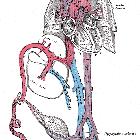umbilical arterial Doppler assessment








Umbilical arterial (UA) Doppler assessment is used in surveillance of fetal well-being in the third trimester of pregnancy. Abnormal umbilical artery Doppler is a marker of placental insufficiency and consequent intrauterine growth restriction (IUGR) or suspected pre-eclampsia.
Umbilical artery Doppler assessment has been shown to reduce perinatal mortality and morbidity in high-risk obstetric situations .
As a general rule, a degree of caution should be exercised with the routine use of Doppler in pregnancy, due to the concerns related to heating/thermal effects from the high intensities of Doppler ultrasound.
Indications
Umbilical Doppler assessment is indicated in scenarios where there is a risk of fetal growth restriction or poor perinatal outcome. It is also used to stage twin-twin transfusion .
Doppler ultrasound evaluation of the fetoplacental circulation is not indicated in low-risk pregnancies .
Maternal conditions
- diabetes mellitus
- chronic kidney disease
- hypertension
- prothrombotic states
Pregnancy-related conditions
- suspected IUGR
- previous pregnancy with IUGR or fetal death in utero
- decreased fetal movement
- oligohydramnios
- polyhydramnios
- multifetal pregnancy
Radiographic features
Doppler ultrasound
The spectral Doppler indices measured at the fetal end, the free loop, and the placental end of the umbilical cord are different with the impedance highest at the fetal end. The changes in the indices are likely to be seen at the fetal end first. Ideally, the measurements should be made in the free cord, however, for consistency of recording in cases being followed up, a fixed site would be more appropriate, i.e. fetal end, placental end, or intra-abdominal portion. Due to difficulty with measuring the cord at the fetal end in many growth-restricted fetuses, measurement in a free loop is acceptable .
Waveform
The umbilical arterial waveform usually has a "sawtooth" pattern with flow always in the forward direction, that is towards the placenta. An abnormal waveform shows absent or reversed diastolic flow. Before the 15 week, the absence of diastolic flow may be a normal finding .
The 95% confidence interval limit slowly decreases for both the resistive index (RI) and pulsatility index (PI) through the course of gestation due to progressive maturation of the placenta and increase in the number of tertiary stem villi.
Parameters
The commonly used parameters are:
- umbilical arterial S/D ratio (SDR): systolic velocity / diastolic velocity
- pulsatility index (PI) (Gosling index): (PSV - EDV) / TAV
- resistive index (RI) (Pourcelot index): (PSV - EDV) / PSV
- PSV: peak systolic velocity
- EDV: end-diastolic velocity
- TAV: time-averaged velocity
The Doppler indices have been found to decline gradually with gestational age (i.e. there is more diastolic flow as the fetus matures):
- S/D ratio mean value decreases with fetal age
- at 20 weeks, the 50 percentile for the S/D ratio is 4
- at 30 weeks, the 50 percentile is 2.83
- at 40 weeks, the 50 percentile is 2.18
- RI mean value decreases from 0.756 to 0.609
- PI mean value decreases from 1.270 to 0.967
Classification of severity
In growth-restricted fetuses and fetuses developing intrauterine distress, the umbilical artery blood velocity waveform usually changes in a progressive manner as below
- reduction in end-diastolic flow: increasing RI values, PI values, and S/D ratio
- absent end-diastolic flow (AEDF): RI = 1
- reversal of end-diastolic flow (REDF)
Further assessment tools
Abnormal umbilical artery Doppler is an indication of further sonographic workup of the degree of placental insufficiency:
See also
- uteroplacental Doppler assessment
automatic online fetal umbilical artery Doppler indices calculator from www.perinatology.com
Siehe auch:
- Intrauterine Wachstumsretardierung
- fetal MCA Doppler assessment
- Nabelarterie
- reversal of end diastolic flow (REDF)
- ductus venosus flow assessment
- absent end diastolic flow (AEDF)
- umbilical venous flow asessment
- uterine arterial Doppler assessment
und weiter:

 Assoziationen und Differentialdiagnosen zu Dopplersonographie der Nabelarterie:
Assoziationen und Differentialdiagnosen zu Dopplersonographie der Nabelarterie:
